LISZT HOUSE - WEIMAR
Summer Garden House of the Composer-Pianist
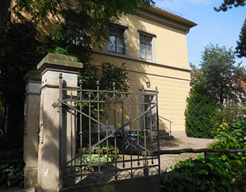 Franz Liszt was born in Hungary in 1811, but he lived for much his life in Germany. A renowned virtuoso pianist and composer, a music teacher and philanthropist, he was an enormous figure in music, not only for his own work, but his support of other musicians. As a composer, he was one of the most prominent representatives of the New German School, noted for his invention of the Symphonic Poem and his innovations in musical forms and harmonies. He was constantly on the move, traveling extensively across Europe playing on tour of the great capitals. He was also a generous and enthusiastic promoter of other musicians, including Frédéric Chopin, Richard Wagner (see Young Wagner Leipzig), Robert Schumann, Hector Berlioz, Camille Saint-Saëns, and Alexander Borodin, and a philanthropist, organizing benefit concerts in support of struggling musicians and causes.
Franz Liszt was born in Hungary in 1811, but he lived for much his life in Germany. A renowned virtuoso pianist and composer, a music teacher and philanthropist, he was an enormous figure in music, not only for his own work, but his support of other musicians. As a composer, he was one of the most prominent representatives of the New German School, noted for his invention of the Symphonic Poem and his innovations in musical forms and harmonies. He was constantly on the move, traveling extensively across Europe playing on tour of the great capitals. He was also a generous and enthusiastic promoter of other musicians, including Frédéric Chopin, Richard Wagner (see Young Wagner Leipzig), Robert Schumann, Hector Berlioz, Camille Saint-Saëns, and Alexander Borodin, and a philanthropist, organizing benefit concerts in support of struggling musicians and causes.
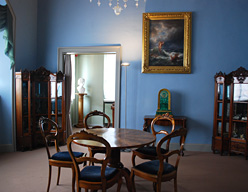 The Liszt House in Weimar is his last official residence where the pianist composer lived during his second residence in Weimar. The house was originally built as a gardener’s lodge just at the edge of the Park in the Ilm, on the Belvedere Allee, the boulevard which led to the Belvedere Castle in Weimar. The castle was the summer palace built for Ernst August, the Duke of Saxe-Weimar in 1728, though after only 20 years, with his death in 1748, the summer palace lost its luster. Over the next half-century the original formal Baroque gardens had gone to seed and when the palace was inherited by the next generation, the Grand Duke Carl Friedrich, the park was transformed in 1811 into the easier to maintain English Landscape garden style it remains today. The long abandoned the house was redesigned in a makeover of Weimar's master German neo-classical architect Clemens Wenzeslaus Coudray in 1819.
The Liszt House in Weimar is his last official residence where the pianist composer lived during his second residence in Weimar. The house was originally built as a gardener’s lodge just at the edge of the Park in the Ilm, on the Belvedere Allee, the boulevard which led to the Belvedere Castle in Weimar. The castle was the summer palace built for Ernst August, the Duke of Saxe-Weimar in 1728, though after only 20 years, with his death in 1748, the summer palace lost its luster. Over the next half-century the original formal Baroque gardens had gone to seed and when the palace was inherited by the next generation, the Grand Duke Carl Friedrich, the park was transformed in 1811 into the easier to maintain English Landscape garden style it remains today. The long abandoned the house was redesigned in a makeover of Weimar's master German neo-classical architect Clemens Wenzeslaus Coudray in 1819.
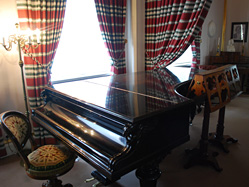 The house location, just a short walk across the boulevard from the university was ideal for resident teachers in Weimar. The building served as a studio for German landscape painter Friedrich Preller the Elder in the 1830s and historical artist Hermann Wislicenius through the 1850s. Franz Liszt moved to Weimar for the second time in 1869 and lived there until his death in 1886.
The house location, just a short walk across the boulevard from the university was ideal for resident teachers in Weimar. The building served as a studio for German landscape painter Friedrich Preller the Elder in the 1830s and historical artist Hermann Wislicenius through the 1850s. Franz Liszt moved to Weimar for the second time in 1869 and lived there until his death in 1886.
During his first time in the city, when he was court musical director from 1848 to 1861, he resided in the Villa Altenburg of Princess Carolyne von Sayn-Wittgenstein. In 1869, after composing the music for the coronation of Emperor Franz Joseph and Elisabeth (Sisi) of Bavaria, as king and queen of Hungary, performed at the ceremony in 1867, Liszt was invited back to Weimar by the Grand Duke Carl Alexander to give master classes in piano and was offered the house with furnishings personally chosen by the Grand Duchess Sophie.
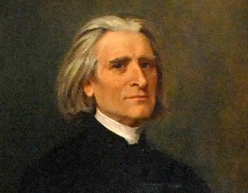 Liszt was visited in Weimar by a parade of illustrious students, with his free lessons held in the house where he taught talented young pianists like Hans von Bülow. After his death in Beyreuth in 1886 from a pneumonia he caught while attending the Beyreuth Festival, the duke and duchess opened part of the house as a memorial. The furnishings in the living rooms and study are the originals as Liszt knew them, while the bedrooms and kitchen are a later reconstruction.
Liszt was visited in Weimar by a parade of illustrious students, with his free lessons held in the house where he taught talented young pianists like Hans von Bülow. After his death in Beyreuth in 1886 from a pneumonia he caught while attending the Beyreuth Festival, the duke and duchess opened part of the house as a memorial. The furnishings in the living rooms and study are the originals as Liszt knew them, while the bedrooms and kitchen are a later reconstruction.
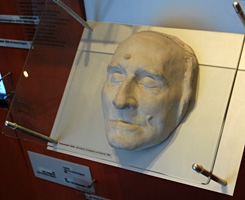 The salon on the first floor still hosts a pair of historic pianos, a Bechstein grand piano, and Ibach piano, two of Liszt’s music holders and two quartet stands. The silent piano in the former servant’s room was used for finger exercises and could be packed up and taken with the composer for his winters in Rome. On the ground floor is a visual and acoustic multimedia exhibition of Franz Liszt’s musical legacy, with busts of several of his illustrious pupils. The exhibit also includes two Liszt death masks.
The salon on the first floor still hosts a pair of historic pianos, a Bechstein grand piano, and Ibach piano, two of Liszt’s music holders and two quartet stands. The silent piano in the former servant’s room was used for finger exercises and could be packed up and taken with the composer for his winters in Rome. On the ground floor is a visual and acoustic multimedia exhibition of Franz Liszt’s musical legacy, with busts of several of his illustrious pupils. The exhibit also includes two Liszt death masks.
Visiting Liszt House Weimar
Open hours are 10am to 6 pm (March to October) Wednesday to Monday, closed Tuesday, 10 am to 4 pm (November to March). Admission is €4.50 for adults is €3.50 concession, student 16-20 €1.50, under 16 free. © Bargain Travel Europe
Find best hotel and vacation deals in Weimar on TripAdvisor
These articles are copyrighted and the sole property of Bargain Travel Europe and WLPV, LLC. and may not be copied or reprinted without permission.
See Also:
GOETHE RESIDENCE & MUSEUM - WEIMAR
SCHILLER RESIDENCE HOUSE - WEIMAR
BACH HOUSE MUSIC MUSEUM - EISENACH
HANDEL HOUSE BIRTHPLACE MUSIC MUSEUM - HALLE
LEOPOLD MOZART BIRTHHOUSE - AUGSBURG

